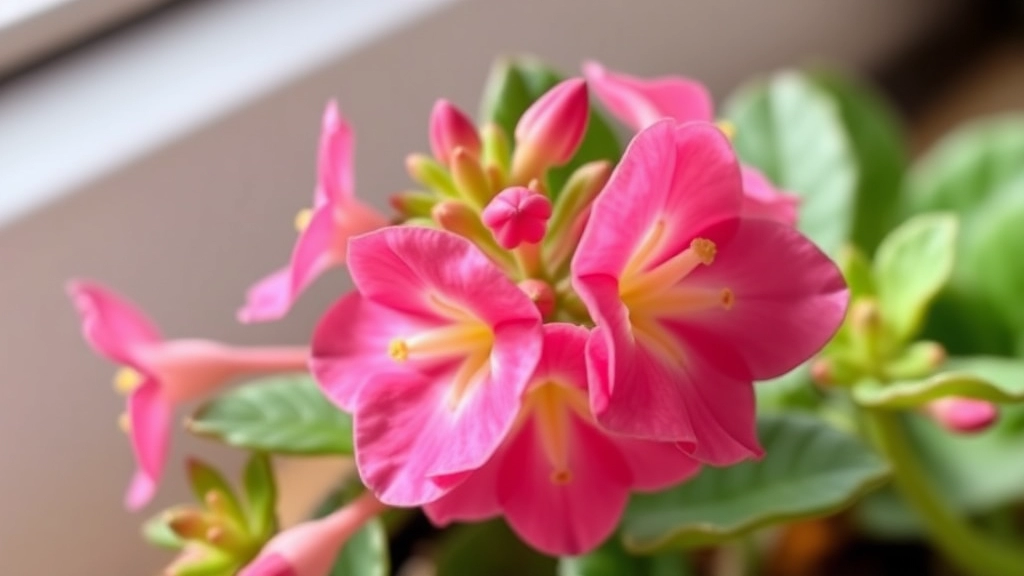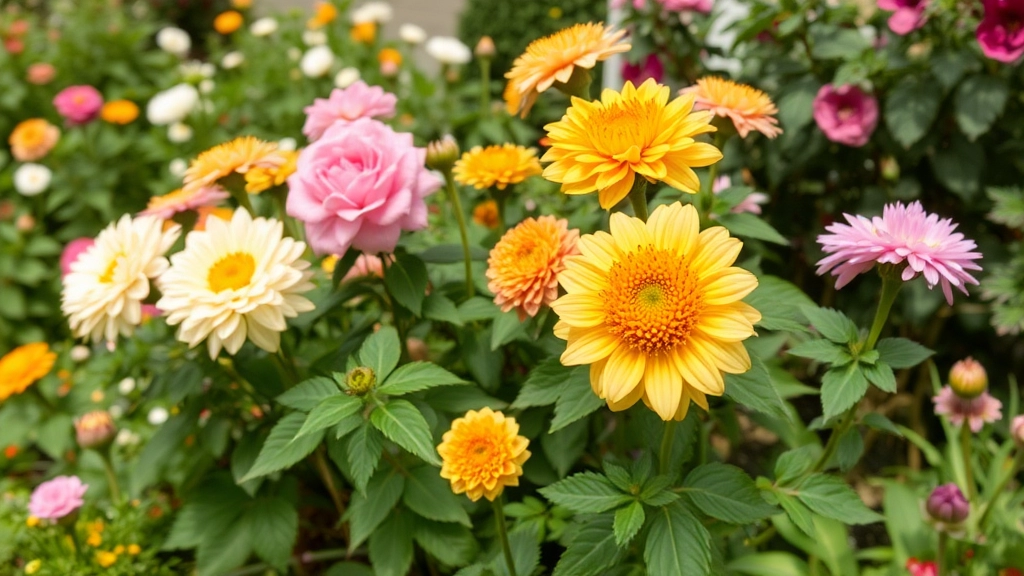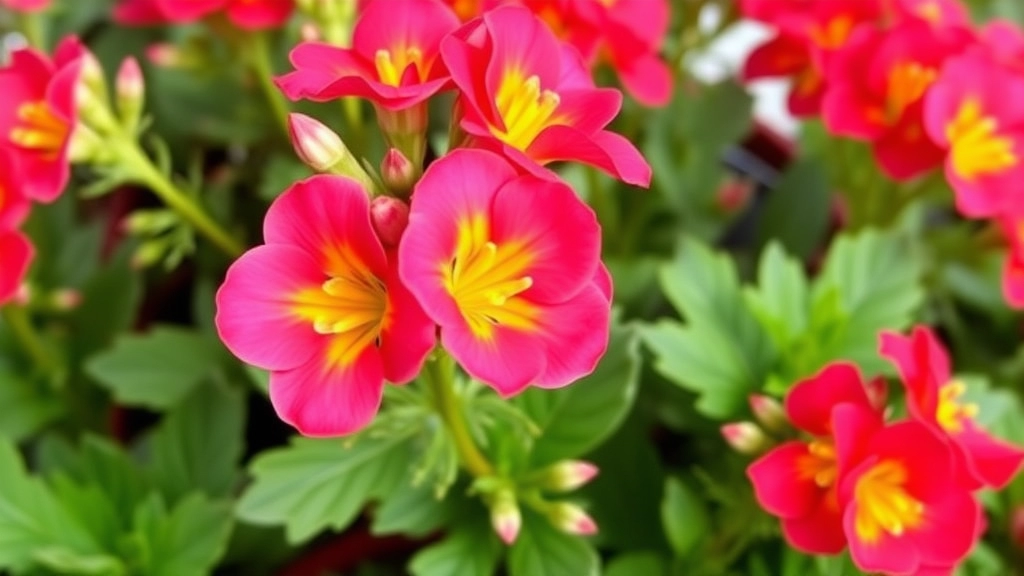Wondering if Kalanchoe blooms all year?
Let’s dive into the blooming cycle of this vibrant plant. Kalanchoe typically flowers in late winter to spring, but with the right care, you can encourage it to rebloom multiple times a year. Proper light, temperature, and watering are key factors to extend its blooming period.
Tips for Keeping Your Kalanchoe Blooming
- Ensure it gets plenty of indirect sunlight
- Maintain a consistent watering schedule
- Adjust light exposure and provide occasional darkness to trigger new blooms
Avoid Common Mistakes
- Overwatering
- Insufficient light
With proper care, your Kalanchoe can reward you with vibrant flowers throughout the year.
Optimal Conditions for Kalanchoe Blooms
Are you struggling to get your Kalanchoe to bloom? You’re not alone. Many plant enthusiasts face challenges with this vibrant succulent, often wondering what conditions are necessary for those stunning flowers to appear.
To ensure your Kalanchoe thrives and produces blooms, consider the following optimal conditions:
- Light: Kalanchoe loves bright, indirect sunlight. A south-facing window is ideal. Too much direct sunlight can scorch the leaves, while too little light will stunt growth and flowering.
- Soil: Use well-draining soil. A cactus or succulent mix works wonders, allowing excess moisture to escape and preventing root rot.
- Temperature: These plants prefer a warm environment. Aim for temperatures between 18°C to 24°C during the day, and slightly cooler at night. Avoid placing them near drafts or heating vents.
- Humidity: Kalanchoe thrives in low to moderate humidity. They are not tropical plants, so avoid overly humid conditions.
- Fertiliser: Feed your Kalanchoe with a balanced fertiliser every 4-6 weeks during the growing season (spring and summer). This will provide the nutrients necessary for healthy growth and blooming.
For more detailed care tips, check out our Complete Care Guide for Kalanchoe Blossfeldiana. If your Kalanchoe still isn’t blooming, you might find our article on Why Your Florist Kalanchoe is Not Flowering helpful.
Encouraging Kalanchoe to Rebloom Indoors

So, you’ve got your Kalanchoe blooming beautifully, but now you’re wondering how to keep that floral magic going indoors.
Here’s the deal: Kalanchoes can be a bit picky when it comes to reblooming, but with the right approach, you can encourage those vibrant flowers to pop up again.
Tips to Encourage Reblooming:
- Light is Key:
- Make sure your Kalanchoe gets plenty of bright, indirect sunlight.
- A south-facing window is ideal. Just avoid direct harsh sunlight, as it can scorch the leaves.
- Prune After Blooming:
- Once the flowers start to fade, give your plant a little trim.
- Snip off the spent blooms and any leggy growth. This encourages new growth and fresh blooms.
- Control the Darkness:
- Kalanchoes need a period of darkness to trigger blooming.
- Aim for about 14-16 hours of darkness each night. Cover them or move them to a darker spot if needed.
- Feed Wisely:
- Use a balanced fertiliser every few weeks during the growing season.
- Look for something that’s high in potassium to promote flowering.
- Temperature Matters:
- Keep your indoor temperature consistent, ideally between 18-24°C.
- Avoid sudden temperature drops, as they can stress the plant.
- Be Patient:
- Sometimes, it just takes a little time for the plant to respond.
- Don’t be discouraged if it doesn’t bloom right away.
By following these simple steps, you’ll be setting the stage for a stunning rebloom.
Managing Light and Darkness for Flowering Cycles
Are you struggling to get your Kalanchoe to bloom? One of the key factors is managing light and darkness effectively.
Kalanchoe plants thrive on a specific light cycle that mimics their natural environment.
Here’s how to manage it:
- Bright, Indirect Light: Kalanchoe loves bright light but avoid direct sunlight, which can scorch the leaves. Place your plant near a window with filtered light.
- Duration of Light Exposure: Aim for about 12 to 14 hours of bright light daily. This encourages healthy growth and prepares the plant for flowering.
- Dark Periods: After the light exposure, ensure your Kalanchoe experiences a dark period of at least 6 hours. This darkness signals the plant to initiate blooming.
- Consistency is Key: Maintain a consistent light and dark cycle. Sudden changes can stress the plant, leading to poor blooming.
- Use Timers: Consider using timers for your grow lights. This ensures your Kalanchoe gets the right amount of light and darkness without any manual effort.
By managing light and darkness effectively, you set the stage for vibrant blooms. For more detailed advice, check out our Ultimate Guide to Flowering Kalanchoe Care. Additionally, if you’re facing issues with your plant not flowering, you might find our article on Why Your Florist Kalanchoe is Not Flowering helpful.
Seasonal Care and Adjustments for Year-Round Blooming

Are you struggling to keep your Kalanchoe blooming throughout the year? You’re not alone. Many plant enthusiasts face challenges when trying to maintain vibrant flowers in different seasons.
To achieve year-round blooms, it’s essential to adjust your care routine according to seasonal changes. Here are some key strategies:
Spring and Summer: Growth Phase
- Light Exposure: Ensure your Kalanchoe receives bright, indirect sunlight.
- Watering: Increase watering frequency as the plant actively grows. Check the soil; it should dry out between waterings.
- Fertilisation: Use a balanced fertiliser every month to promote healthy foliage and flower development.
Autumn: Preparing for Dormancy
- Reduce Watering: As temperatures drop, cut back on watering to prevent root rot.
- Light Management: Gradually reduce the amount of light your Kalanchoe receives to mimic natural conditions.
Winter: Dormant Phase
- Temperature Control: Keep the plant in a cooler environment, ideally between 10-15°C.
- Minimal Watering: Water sparingly, only when the soil is completely dry.
- Darkness: Ensure the plant gets long periods of darkness to encourage future blooming.
Tips for Seasonal Adjustments
- Observation: Regularly check your plant for signs of stress or changes in growth.
- Adaptability: Be prepared to adjust your care routine as needed, based on the plant’s response.
Common Mistakes That Prevent Reblooming
When striving for those vibrant Kalanchoe blooms, it’s easy to overlook a few key factors that can hinder their reblooming potential.
Have you ever wondered why your Kalanchoe isn’t flowering again after its initial display?
Here are some common mistakes that can prevent your plant from thriving:
- Inadequate Light: Kalanchoes need bright, indirect sunlight. Placing them in low-light areas can stifle their blooming cycle.
- Overwatering: It’s tempting to keep the soil moist, but Kalanchoes prefer to dry out between waterings. Ensure the pot has good drainage.
- Neglecting Pruning: Failing to prune spent blooms can lead to energy being wasted on dead flowers rather than new growth. Regularly snip off the faded flowers to encourage new ones. For more tips, check out our postbloom Kalanchoe care guide.
- Ignoring Temperature Needs: Kalanchoes thrive in warmer temperatures. A sudden drop in temperature can shock the plant and halt blooming.
- Lack of Fertilisation: While Kalanchoes don’t require heavy feeding, a balanced fertiliser during the growing season can promote healthy blooms.
- Not Providing a Dormancy Period: After the blooming season, Kalanchoes need a rest period. Skipping this can lead to fatigue and fewer flowers. Learn more about flowering Kalanchoe care to ensure your plant gets the rest it needs.
By addressing these common pitfalls, you can create a more conducive environment for your Kalanchoe to flourish and rebloom.
Watering and Temperature Tips for Extended Blooming
So, you’ve got your Kalanchoe blooming beautifully, but how do you keep those vibrant flowers coming back for more?
Watering Wisely
First up, let’s talk about watering. It’s a bit of an art form with Kalanchoe.
- Let It Dry: Always let the soil dry out completely between waterings.
- Deep Soaks: When you do water, give it a good soak. Let the water drain out of the pot’s bottom to ensure the roots are getting enough love.
- Frequency: Generally, this means watering every 2-3 weeks, but keep an eye on the soil moisture.
Temperature Matters
Now, onto temperature. Kalanchoe loves a warm environment, but not too hot!
- Ideal Range: Aim for a cozy 18-24°C (65-75°F) during the day.
- Night Chills: At night, it can drop to around 10-15°C (50-60°F).
- Avoid Drafts: Keep your plant away from cold drafts or heat sources.
Humidity Check
Kalanchoe isn’t a fan of high humidity.
- Keep It Dry: A humidity level of 40-50% is ideal.
- Ventilation: Good airflow can make a world of difference.
Quick Recap
- Water only when dry: Deep soak, let drain.
- Temperature: 18-24°C (day), 10-15°C (night).
- Humidity: Keep it low and ventilated.
For more detailed tips on maintaining the health of your Kalanchoe, check out our optimal watering tips for healthy florist Kalanchoe. Additionally, if you are facing issues with your Kalanchoe’s blooming cycle, our guide on why your non-flowering Kalanchoe isn’t blooming can offer some valuable insights.
FAQs About Kalanchoe Blooming
Does Kalanchoe Bloom All Year?
Kalanchoes typically do not bloom all year. They have specific blooming periods, often requiring adjustments in care to encourage reblooming.
How Can I Encourage My Kalanchoe to Rebloom Indoors?
To encourage indoor reblooming, ensure your Kalanchoe gets bright, indirect sunlight, prune after blooming, control the darkness, feed wisely, maintain consistent temperatures, and be patient.
What Kind of Light Does Kalanchoe Need for Reblooming?
Kalanchoe needs plenty of bright, indirect sunlight. A south-facing window is ideal, but avoid direct harsh sunlight to prevent scorching the leaves.
How Should I Prune My Kalanchoe After Blooming?
After the flowers fade, trim the plant by snipping off the spent blooms and any leggy growth. This encourages new growth and fresh blooms.
Why Is Darkness Important for Kalanchoe Blooming?
Kalanchoes need about 14-16 hours of darkness each night to trigger blooming. You may need to cover them or move them to a darker spot to achieve this.
What Type of Fertiliser Should I Use for Kalanchoe?
Use a balanced fertiliser every few weeks during the growing season. A fertiliser high in potassium is ideal for promoting flowering.
What Temperature Is Best for Indoor Kalanchoe Plants?
Keep the indoor temperature consistent, ideally between 18-24°C. Avoid sudden temperature drops, as they can stress the plant.
How Do I Adjust Kalanchoe Care for Year-Round Blooming?
Adjust your care routine based on the season. Increase light and watering in spring and summer, reduce watering and light in autumn, and keep the plant cooler with minimal watering in winter.
What Should I Do During the Kalanchoe’s Dormant Phase in Winter?
During winter, keep the plant in a cooler environment (10-15°C), water sparingly, and ensure it gets long periods of darkness to encourage future blooming.
How Often Should I Water My Kalanchoe in Different Seasons?
In spring and summer, increase watering frequency but let the soil dry out between waterings. In autumn, reduce watering, and in winter, water sparingly only when the soil is completely dry.
What Are Some Tips for Seasonal Adjustments in Kalanchoe Care?
Regularly observe your plant for signs of stress or changes in growth, and be adaptable in adjusting your care routine based on the plant’s response.
References
-
How to Make a Kalanchoe Bloom Again â Gardening Know How
-
How to Grow and Care for Kalanchoe Indoors â The Spruce
-
Kalanchoe: How to Grow and Care for Kalanchoe Plants â The Old Farmer’s Almanac
